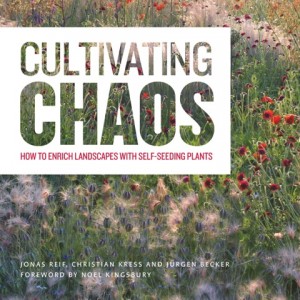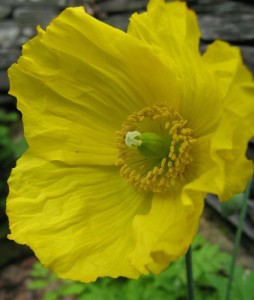Self-seeders are nature’s great opportunists – but earth-friendly gardening can improve their odds.
I’m a flinger, a scatterer, a dropper, sometimes a flicker, and quite often a shover. A bit of an all-round chancer, in fact. But it’s not me that’s out to try my luck by exploiting a bit of bare soil here, or a crack in the wall or paving there. I’m just the runner for the seeds of fecund, opportunist plants that can fill the most unlikely corners of a garden with flower-filled, nature-friendly abundance. I’m talking about what are known as ‘self-seeding’ plants – those producing an abundance of seeds that will grow just about anywhere, including those spots you assumed weren’t worth bothering with.

In my rain-feted Welsh garden, my iconic self-seeder is pot marigold (Calendula officinalis). I have now impregnated the soil with so many of its seeds – by allowing the strongest plants to flower and seed their socks off – that I’ll never need to sow it again (and nor will my successors). Each spring its chunky, slightly sticky seedlings are among the first to break the warming soil. They come up everywhere, winging it in the middle of beds, in cracks along path edging, and even in my home-made peat-free sowing and potting mix. By mid-summer, they’re beacons of yellow and orange, besieged by bees of all denominations, and irresistible helipads for adult hoverflies, parasitoid wasps, flies, and much more. I’ll pot up some late-summer-germinated seedlings for extra-early, hoverfly-luring flowers in my greenhouse the following spring.

The simple, ‘single’ varieties – ones with a distinct central ‘eye’ surrounded by a ring of petals – are the ones to scatter for maximum insect appeal. Pot marigolds have big, weird-looking seeds; I flung them around by the handful the first chance I had, and I still drop some into the compost bin (an effortless, stealthy spreading technique). My gardening becomes more fluid, more relaxed as time passes; the makers of some of the most vibrant earth-friendly gardens I know follow a simple, timeless maxim: mix everything up. Self-seeders are the ultimate, easy-going mixers which get along well with their neighbours, be they other flowers, vegetable crops or fruits.
Chancing self-seeders are the ultimate in effortless, truly renewable gardening; they sow themselves, profusely, germinate and come up when the time’s just right, and are generally easy to nip or thin out with a hoe, or pull up if they turn thuggish. Most supply nectar and pollen as long as they’re in bloom, and they don’t need mollycoddling (or spraying with anything nasty). Other sow-once-and-flower-forever favourites here are Welsh poppy (Meconopsis cambrica), borage, California poppy (eschscholzia), echium and foxglove. Having let various oriental brassicas flower – their yellow, pungent flowers send hoverflies into a frenzy – and go to seed, I enjoy impromptu pickings of salad leaves, mizuna and red mustard among them.

I thought I knew a fair bit about growing these chancers, and how best to deploy them. Then I discovered Cultivating Chaos: How to Enrich Landscapes with Self-Seeding Plants. There aren’t many gardening books I’m tempted to shout loudly and tell the world about, but this is one of them (probably because I wish I’d written it myself). One thing: don’t be deterred by ‘landscape’ in the title; just blur your vision and read ‘gardens’ instead. That’s what this book is about.
Cultivating Chaos inhabits full-on gardening-drool territory. It is packed with everything a book devoted to self-seeders needs: eye-catching images with ‘I must try that on my patch’ plant combos, and solid, practical and well-ordered gardener-friendly information. Its garden case studies, where you can see self-sown chancers shine, have nudged Derek Jarman’s garden at Dungeness, and Waltham Place in Berkshire, to the top of my must-visit list. Kent’s Great Dixter is also down for a long-overdue return visit. I’m also tempted by European treasures; Het Vlackeland in The Netherlands is another saliva-inducing garden where self-seeders are stars.

There’s cracking advice on making weed-resisting paths from gravel (which won’t need dousing in weedkiller), and suggestions of self-seeders for letting loose in masonry and drystone walls, in shingle and gravel areas, in flower borders, and among perennial plants. This fine-tuned tome even highlights chancers partial to full or dappled shade. I’m wondering if I can tempt biennial alexanders (Smyrnium perfoliatum) to take up residence up on the bank where the oak’s summer shadows dance.
One of my favourite chancers, the Welsh poppy, more than earns its keep here. Not only do its blooms smell of pear drops (get your snout well in to appreciate it), they are one of the most prolific refuelling stops for bees, especially bumbles, in mid- to late spring. They flourish in the older bits of drystone slate walling here, but I’m struggling to get them to love the ‘new’ walls, built over the last decade with reclaimed slate. I’ve flicked and shoved their tiny seeds into nooks and crannies, but few if any ever get going. A tip gleaned from Cultivating Chaos is hopefully set to turn my fortune and spread their crepe paper-like yellow and orange blooms far and wide.
All I need is a cake icing bag, or even just a strong plastic bag, plus a palmful of poppy seeds, some sieved soil/leafmould, and water, mixed together into sloppy mud, and then bagged up. This is then worked, by squeezing the bag, into as many cracks and crevices (horizontal and vertical) as possible. And that’s it. If it turns very dry, you can gently moisten the wall with a fine spray of water, taking care not to wash the ‘icing’ away, until seedlings appear. I might add a dash of foxglove seeds, too – they’re always good here for adding vertical delight.
I’ve shoved, flicked, dropped, scattered and flung chancers all around my patch. I never thought I’d end up squirting them, too.
Cultivating Chaos: How to Enrich Landscapes with Self-Seeding Plants (J. Becker, C. Kress and J. Reif, Timber Press, 2015, ISBN-13 978-1-60469-652-3, RRP £25)
Text and images © John Walker. Book cover image courtesy of Timber Press.
Find John on Twitter @earthFgardener


